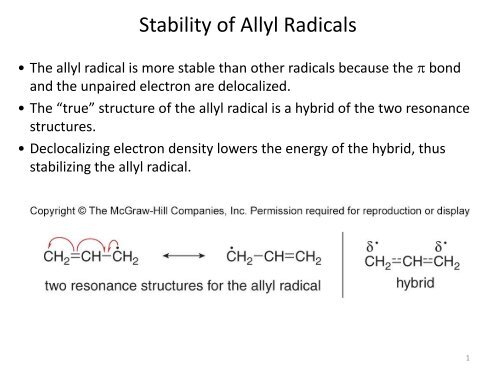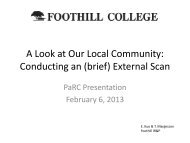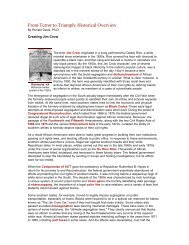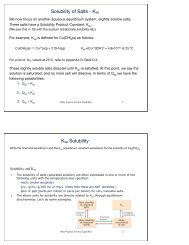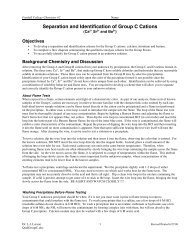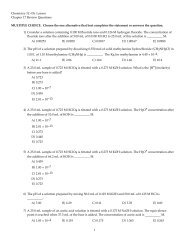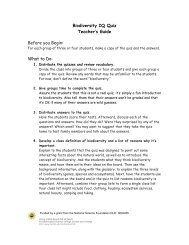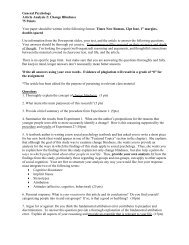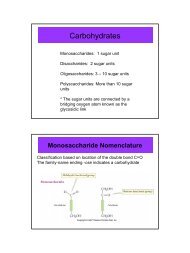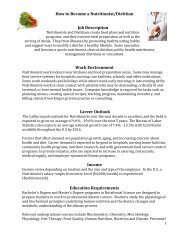Stability of Allyl Radicals
Stability of Allyl Radicals
Stability of Allyl Radicals
Create successful ePaper yourself
Turn your PDF publications into a flip-book with our unique Google optimized e-Paper software.
<strong>Stability</strong> <strong>of</strong> <strong>Allyl</strong> <strong>Radicals</strong><br />
• The allyl radical is more stable than other radicals because the p bond<br />
and the unpaired electron are delocalized.<br />
• The “true” structure <strong>of</strong> the allyl radical is a hybrid <strong>of</strong> the two resonance<br />
structures.<br />
• Declocalizing electron density lowers the energy <strong>of</strong> the hybrid, thus<br />
stabilizing the allyl radical.<br />
1
<strong>Radicals</strong><br />
• A significant group <strong>of</strong> reactions involve radical intermediates.<br />
• A radical is a reactive intermediate with a single unpaired electron,<br />
formed by homolysis <strong>of</strong> a covalent bond.<br />
• A radical contains an atom that does not have an octet <strong>of</strong> electrons.<br />
• Half-headed arrows are used to show the movement <strong>of</strong> electrons in<br />
radical processes.<br />
2
Structure <strong>of</strong> <strong>Radicals</strong><br />
• Carbon radicals are classified as 1°, 2°, or 3°.<br />
• A carbon radical is sp 2 hybridized and trigonal planar, like carbocations.<br />
• The unhybridized p orbital contains the unpaired electron and extends<br />
above and below the trigonal planar carbon.<br />
3
Figure 15.1<br />
The relative stability <strong>of</strong> 1°<br />
and 2° carbon radicals<br />
<strong>Stability</strong> <strong>of</strong> <strong>Radicals</strong><br />
4
General Features <strong>of</strong> Radical Reactions<br />
• <strong>Radicals</strong> are formed from covalent bonds by adding energy in the form <strong>of</strong><br />
heat () or light (h).<br />
• Some radical reactions are carried out in the presence <strong>of</strong> a radical<br />
initiator.<br />
• Radical initiators, such as peroxides <strong>of</strong> general structure, RO–OR, contain<br />
an especially weak bond that serves as a source <strong>of</strong> radicals.<br />
• Heating a peroxide readily causes homolysis <strong>of</strong> the weak O–O bond,<br />
forming two RO• radicals.<br />
• <strong>Radicals</strong> undergo two main types <strong>of</strong> reactions—they react with bonds,<br />
and they add to p bonds.<br />
5
Reaction <strong>of</strong> a Radical X• with a C–H Bond<br />
• A radical X•, once formed, rapidly reacts with whatever is available,<br />
usually a stable or p bond.<br />
• A radical X• abstracts a hydrogen atom from a C–H bond to form H–X<br />
and a carbon radical.<br />
6
Reaction <strong>of</strong> a Radical X• with a C=C Bond<br />
• A radical X• also adds to the p bond <strong>of</strong> a carbon–carbon double bond.<br />
• In either type <strong>of</strong> radical reaction (with a or p bond) a new radical is<br />
created.<br />
7
Inhibition <strong>of</strong> <strong>Radicals</strong> by Molecular Oxygen<br />
• Occasionally, two radicals react to form a sigma bond.<br />
• An example is the reaction <strong>of</strong> a radical with oxygen (a diradical in its<br />
ground state electronic configuration).<br />
• Reaction with oxygen causes the reaction to slow down or stop, as X–O–<br />
O• radicals are not as reactive as halogen radicals.<br />
• Compounds that prevent radical reactions from occurring are called<br />
radical inhibitors or radical scavengers.<br />
8
Radical Halogenation <strong>of</strong> Alkanes<br />
• In the presence <strong>of</strong> heat or light, alkanes react with halogens to form alkyl<br />
halides by a radical substitution reaction.<br />
• Halogenation <strong>of</strong> alkanes is only useful with Cl 2 or Br 2.<br />
• Reaction with F 2 is too violent, and reaction with I 2 is too slow to be<br />
useful.<br />
• With an alkane that has more than one type <strong>of</strong> hydrogen atom, a mixture<br />
<strong>of</strong> alkyl halides may result.<br />
9
• When a single hydrogen atom on a carbon has been replaced by a<br />
halogen atom, monohalogenation has taken place.<br />
• When excess halogen is used, it is possible to replace more than one<br />
hydrogen atom on a single carbon with halogen atoms.<br />
• Monohalogenation can be achieved experimentally by adding halogen X 2<br />
to an excess <strong>of</strong> alkane.<br />
Figure 15.2<br />
Complete halogenation <strong>of</strong><br />
CH 4 using excess Cl 2<br />
Radical Halogenation <strong>of</strong> Alkanes<br />
10
Halogenation <strong>of</strong> Alkanes—Mechanism<br />
• Three facts about halogenation suggest that the mechanism involves<br />
radical, not ionic, intermediates:<br />
11
Common Steps <strong>of</strong> Radical Reactions<br />
• Radical halogenation has three distinct steps:<br />
• This type <strong>of</strong> mechanism that involves two or more repeating steps is<br />
called a chain mechanism.<br />
• The most important steps <strong>of</strong> any chain mechanism including radical<br />
halogenation are the propagation steps which lead to product formation.<br />
12
Figure 15.4<br />
Energy Diagram for Radical Propagation<br />
14
Product Mixture in Radical Chlorination<br />
• Chlorination <strong>of</strong> CH 3CH 2CH 3 affords a 1:1 mixture <strong>of</strong> CH 3CH 2CH 2Cl and<br />
(CH 3) 2CHCl.<br />
• CH 3CH 2CH 3 has six 1° hydrogens and only two 2° hydrogens, so the<br />
expected product ratio <strong>of</strong> CH 3CH 2CH 2Cl to (CH 3) 2CHCl (assuming all<br />
hydrogens are equally reactive) is 3:1.<br />
15
Radical Halogenation <strong>of</strong> Alkanes<br />
• Since the observed ratio between CH 3CH 2CH 2Cl and (CH 3) 2CHCl is 1:1, the<br />
2° C–H bonds must be more reactive than the 1° C–H bonds.<br />
• Thus, when alkanes react with Cl 2, a mixture <strong>of</strong> products results, with<br />
more product formed by cleavage <strong>of</strong> the weaker C–H bond than you<br />
would expect on statistical grounds.<br />
16
Chlorination vs Bromination<br />
• Although alkanes undergo radical substitutions with both Cl 2 and Br 2,<br />
chlorination and bromination exhibit two important differences.<br />
1. Chlorination is faster than bromination.<br />
2. Chlorination is unselective, yielding a mixture <strong>of</strong> products, but<br />
bromination is more selective, <strong>of</strong>ten yielding one major product.<br />
17
Energy <strong>of</strong> Halogenation<br />
• The differences in chlorination and bromination can be explained by<br />
considering the relative energetics <strong>of</strong> their key propagation steps.<br />
• Calculating H o using bond dissociation energies reveals that abstraction<br />
<strong>of</strong> a 1° or 2° hydrogen by Br• is endothermic.<br />
• However, it takes less energy to form the more stable 2° radical, and this<br />
difference is more important in endothermic steps.<br />
18
Energy Diagram for Endothermic Reaction—<br />
Bromination<br />
Figure 15.5<br />
• Because the rate-determining step is endothermic, the transition state<br />
resembles the products.<br />
• The more stable radical is formed faster, and <strong>of</strong>ten a single radical<br />
halogenation product predominates.<br />
19
Energy <strong>of</strong> Radical Formation<br />
• Calculating H° using bond dissociation energies for chlorination reveals<br />
that abstraction <strong>of</strong> a 1° or 2° hydrogen by Cl• is exothermic.<br />
• Since chlorination has an exothermic rate-determining step, the<br />
transition state to form both radicals resembles the same starting<br />
material, CH 3CH 2CH 3.<br />
• Thus, the relative stability <strong>of</strong> the two radicals is much less important, and<br />
both radicals are formed.<br />
20


